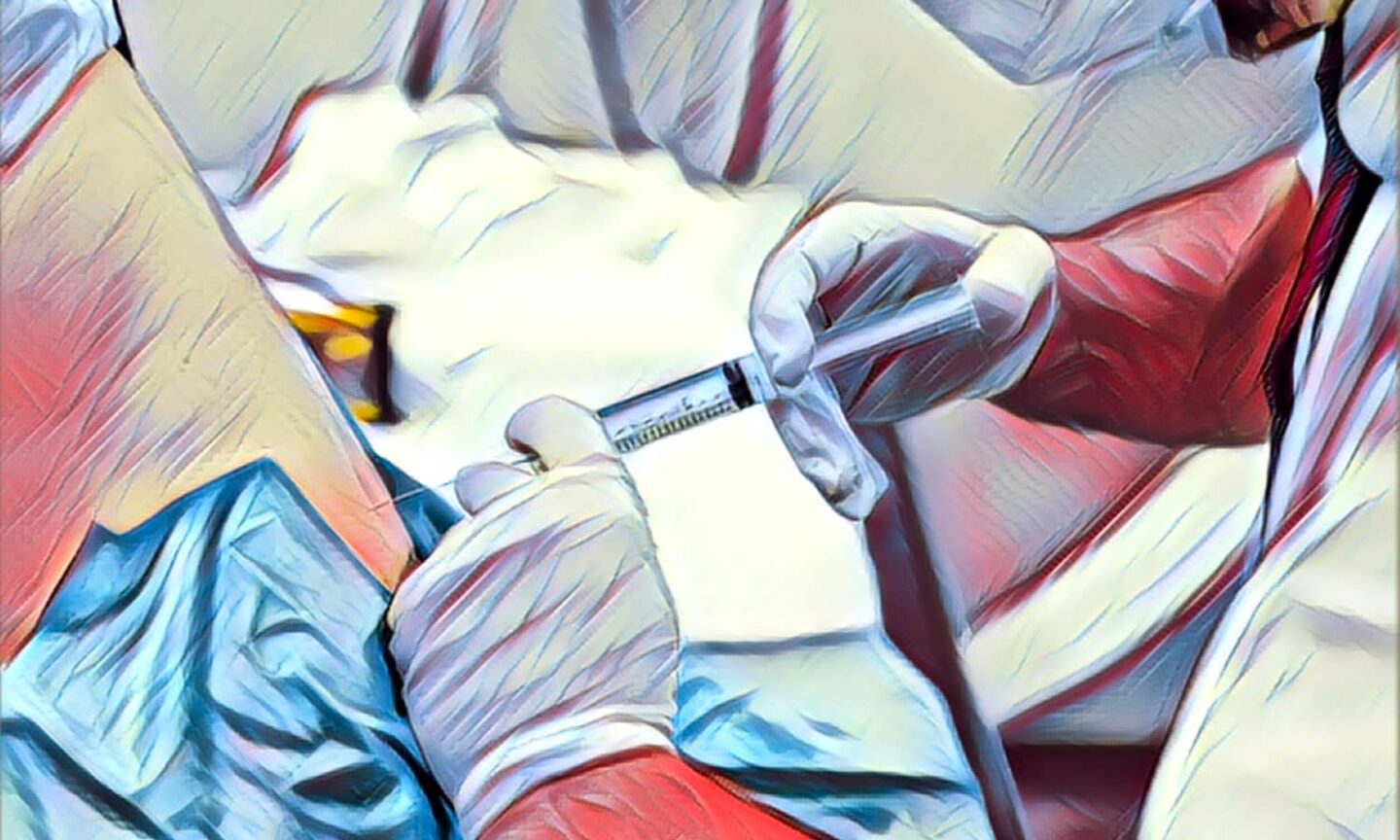Pain management injections Types of injections and nerve blocks
Call Pain Specialists WA in Perth:

What are pain management injections/nerve blocks?
Injections and nerve blocks are used in pain medicine to help diagnose the origin of your pain and provide a treatment option for a range of pain conditions.
Diagnostic injections:
Sometimes, it is very difficult to identify the exact cause of your pain. Injections can be very useful to pinpoint the pain source and help with management strategies.
Pain reduction:
Depending on your individual case, injections can provide very good pain relief that lasts long. Combined with physiotherapy and rehabilitation, the body starts to mend and your quality of life improves.
A lot of people know cortisone injections, but pain specialists offer a range of injections to treat pain. Most of them include injecting local anaesthetics and cortisone, which is a steroid. However, it’s important to understand that the results of each injection can vary based on a few important factors. For example: Where is the injection given? How is it done? What specific method is chosen to treat the condition? All of these factors play a role in the effectiveness of the injection.
Injections may not be suitable for everyone. In carefully selected cases, strategically applied injections can be very helpful to speed up a patient’s recovery.
In general, an injection refers to the process of injecting a medication or solution into a specific site in the body to alleviate pain, reduce inflammation or diagnose the source of pain.
A nerve block is a specific type of injection that targets and numbs specific nerves or nerve clusters to alleviate pain. By blocking the nerve’s ability to transmit pain signals, a nerve block can provide pain relief for a specific area of the body.
In summary, all nerve blocks are injections, but not all injections are nerve blocks.
List of injections and nerve blocks

Here is a comprehensive list of different pain management injections and nerve blocks used in pain medicine. Each injection/nerve block targets a specific condition.
Cluneal nerve blocks
The cluneal nerves are a group of nerves in your lower back, near your spine. They travel through your muscles and other tissues in the lower back and buttock region and they send sensory signals from the skin, muscles and other structures back to the spinal cord and brain. In short, the cluneal nerves help us to feel touch, temperature and pain in that area.
When these nerves get inflamed or compressed, they cause pain – particularly above the pelvis.
Cluneal nerve blocks are injections that aim to reduce the pain and sensitivity in that area. Your pain specialist will inject an anaesthetic near the cluneal nerves, helping to numb them so they can no longer send pain signals to the brain. By blocking these nerves, the pain can be reduced or even completely disappear for a period of time.
Coeliac plexus blocks
The coeliac plexus is a cluster of nerves located in your abdomen. It helps to send messages and control sensations from organs like your pancreas, liver, and stomach.
Coeliac plexus blocks involve injecting a local anaesthetic or neurolytic agent near these nerves to relieve chronic abdominal pain. They can be very helpful to alleviate intractable pain in cancer patients.
Disc injection
Discs are considered to be the cushion located between the vertebral bones in the spine. Discs can develop wear and tear and degenerative changes. Most of the time, these degenerative changes don’t cause any major problems, but sometimes they can cause severe back pain.
Disc injection is a procedure where the aim is to inject medication inside the disc.
There are few very important factors to note;
- The evidence supporting the use of this injection in the medical literature is very limited.
- Disc injections or disc blocks can cause an infection inside the disc (discitis) or cause nerve irritation. In particular, discitis is a serious complication that can cause severe pain for months, requiring hospital admission and months of antibiotic use.
Considering these risks, at Pain Specialists WA we are highly selective when it comes to recommending disc blocks. We only offer this type of injection in cases where the pain has not responded to other treatments, including:
- physical therapy,
- rehabilitation,
- analgesia,
- simple injections
- and if the pain is greatly impacting your quality of life, preventing you from working, socialising, and resting.
Having said that, our pain specialists have seen this injection to be highly effective in selected patients.
Epidural injection
The epidural space is an area that surrounds the spinal cord and nerves within the vertebral canal.
Administering an injection into this space can help with certain conditions such as herniated discs, nerve impingement, sciatica, and canal stenosis. By injecting a combination of local anaesthetics, cortisone and sometimes clonidine, inflammation, swelling, and pain can be reduced.
There are different techniques to administer an epidural injection, including caudal epidural, direct epidural and transforaminal epidural. The choice of technique depends on your specific condition and your pain specialist will decide which one is most suitable for you.
Facet joint injection
Facet joints, like any other joints, can develop arthritis. To address this, we inject cortisone directly inside the facet joint. This can reduce inflammation and alleviate pain coming from the facet joint. The duration of pain relief varies from one day to a few months.
At Pain Specialists WA in Perth we consider facet joint injections to be a valuable diagnostic tool.
There are a few important points worth paying attention to:
- We inject all the arthritic and affected facet joints that are most likely causing pain in one session.
- We inject local anaesthetics and cortisone together
- The local anaesthetic only lasts for 12-16 hours. This time is very important!
- During the first 12-16 hours after the facet joint injection, you must remain active. In fact, we want you to perform activities that are usually painful. If you feel really good and are able to do the painful activities very comfortably during the 12-16 hours after the facet joint injection, we can make different treatment plans for you which would give you months up to a year of pain relief.
Ganglion impar blocks
The ganglion impar is a group of small nerves located in front of your tailbone (coccyx).
Ganglion impar blocks involve the injection of medication near these nerves and are administered to reduce pain in conditions such as coccydynia or painful tailbone.
Genicular block (knee block)
The knee joint is innervated by genicular nerves. These nerves are responsible for transmitting pain signals from the knee joint. Injections to these nerves can alleviate the pain coming from the knee joint. When you have a knee problem, like arthritis or even sometimes after a knee surgery, these nerves can send a lot of pain signals. Giving these nerves an injection can “put them on mute”, helping to ease the pain you’re feeling from your knee.
“Headache and migraine” procedure
Headaches are one of the most common and painful conditions. There are many reasons why one might have a headache. While simple measures are often useful in controlling headaches, sometimes pain specialists may suggest injections.
For example; anti wrinkle drugs that temporarily relax muscles in the head, neck, and scalp. This procedure involves injecting at specific points in the forehead, temple, or back of the head. It is generally well tolerated and can be used for spasmodic muscles and certain special conditions. Ask for leaflets for more details.
Another procedure is the occipital nerve block, which can be very effective in certain conditions.
Sometimes arthritic changes in the neck can cause headaches, and injections targeted at those areas in the neck can be helpful.
Injection into the joint space and intra-articular injection
There are special solutions that mimic the fluid inside the joints. These solutions act like lubricants.
At Pain Specialists WA, we inject the solution into the very arthritic joints (often the knees) and combine this with targeting the nerve supply of that particular joint to have the best outcome.
An intra-articular injection is typically administered to treat arthritis, which refers to the “wear and tear” of a joint. By injecting cortisone directly into the affected joint, inflammation can be reduced, and pain can be alleviated.
Nerve root sleeve injection
Spinal nerves originate from the spinal cord, and they exit the spine through an opening called the foramen. Occasionally, the foramen can narrow and start irritating the nerve, causing nerve pain. Sometimes disc bulges inside the spine start touching the nerve, causing discomfort. Additionally, infections like shingles or post-spine surgery can lead to inflammation of the nerves, causing neuropathic pain.
The aim of nerve root sleeve injection is to target the base of the nerve and inject medications close to the nerve to reduce inflammation.
This type of injection can also be used as a diagnostic tool, especially in cases where there might be a possibility that multiple nerves are causing pain. This way, we can identify which section of the spine is causing the pain and focus on that area.
Paravertebral blocks
The paravertebral space refers to the area alongside the spine and contains spinal nerves. Injecting paravertebral blocks numbs the nerves in that area.
Generally, this procedure is done in conjunction with inserting a special catheter that is connected to a pump to inject local anaesthetics for a few days. It is very useful after certain surgeries or conditions like broken ribs.
Peripheral nerve blocks
Peripheral nerves start from the spinal cord and spread out to all parts of your body. They help your brain understand what’s happening in your body and enable you to interact with the world around you.
Peripheral nerve blocks are administered around these nerves to treat a variety of conditions. They are known to be effective in managing nerve pain after hernia repair, nerve entrapment caused by post-surgery scar tissue, carpal tunnel syndrome and many other conditions.
Rhizotomy
Sacroiliac joint injection
Sacroiliac joint pain is a common condition that can be caused by a variety of reasons, including arthritis, inflammation like ankylosing spondylitis, trauma and accidents or even childbirth.
A simple cortisone injection can be very helpful to settle down the inflammation.
If the pain relief after a simple injection doesn’t last long, a pain specialist can offer more comprehensive management strategies.
Shoulder injection
Your shoulder is one of the most mobile joints in your body. Shoulder pain can be caused by a variety of reasons including bursitis, rotator cuff issues, tendon tears or arthritis.
Depending on its cause, a pain specialist can offer a variety of pain management injections like:
- Subacromial bursa injection
- Suprascapular nerve block
- Acromioclavicular injection
Sphenopalatine ganglion blocks
The sphenopalatine ganglion is a group of nerve cells located behind your nose and they play an important role in transmitting pain signals from the nose, sinuses and other parts in that area.
Sphenopalatine ganglion blocks are injections that pain specialists use to alleviate chronic facial pain and cluster headaches.
Stellate ganglion blocks
The stellate ganglion is a cluster of nerves located in front of your neck. They play an important role in regulating blood flow.
Stellate ganglion blocks are pain management injections that can be useful in treating conditions such as upper limb complex regional pain syndrome (CRPS) and post-traumatic stress disorder (PTSD).
Suprascapular nerve blocks
Suprascapular nerves originate from the brachial plexus and travel to the shoulder blade area (suprascapular region). They play an important role in shoulder function and sensation.
Suprascapular nerve blocks involve the injection of medication near these nerves to provide targeted pain relief for conditions such as rotator cuff injuries or arthritis. Depending on the condition, the branches of the suprascapular nerve should be injected at the same time.
Sympathetic block
Sympathetic nerves are part of the autonomic nervous system, regulating involuntary functions or processes and actions that we do automatically and not control consciously (think for example of shivering in cold weather, opening and closing the pupil).
Sympathetic blocks involve injecting medication or anaesthetic near the sympathetic nerves to interrupt pain signals. This procedure is used to manage conditions like complex regional pain syndrome, sympathetic-mediated pain, or vascular disorders.
Variety of pain-relief injections offered at Pain Specialists WA in Perth

There are many other types of injections that we can provide at Pain Specialists WA.
Examples are:
- Injection into greater occipital nerve (is known as GON block) for certain types of headache,
- Hip injection for conditions coming from hip like arthritis,
- Intercostal nerve block in cases like shingle related pain,
- Greater trochanteric injections (commonly known as hip bursa injection).
Not every condition is suitable for an injection. When you visit us at Pain Specialists WA, we will complete a thorough pain assessment before offering you any injections. Pain management injections are only a small part of your comprehensive management plan and they are tools to help improve your condition and get you back on track.
Risks of pain management procedures

Like any medical procedure, injections performed for pain management, do come with certain risks. Some of the risks are more frequent that others, such as temporary increase in the pain (pain flare up), soreness at the site of injection, bruises or swellings.
- Pain flare up. It is not uncommon to have temporary discomfort after certain procedures. It is commonly observed after thermal rhizotomy. Other procedures such as nerve root sleeve injection can cause temporary pain flare up. A short course of pain medication often settles down these symptoms.
- Headache. Risk of developing headache after epidural or nerve root sleeve injections is around 1 in 100 cases. If it happens, few days of rest, hydration and simple pain killers often is sufficient. Come cases may require a repeat of epidural injection to help with the headache.
- Temporary numbness. This often occurs due to the local anaesthetics which numbs the nerves. The sensation will return once the local anaesthetics is worn off.
- Difficulty controlling bladder and low blood pressure. They may occur after epidural injection. Sometimes you may need intravenous fluid or a temporary catheter. These symptoms resolve by itself once the local anaesthetics is worn off.
It is very hard to give an accurate statistics for each of the below complications. I quote 1 in 2,000 case to be a rare complication. These are:
- Infection: At the site of injection or in the body.
- Bleeding or haematoma: Sometimes, you may bleed too much and end up having a haematoma which is a blood collection in the tissue. It is important to let us know if you are taking any blood thinning medications, fish oil, or herbal medicine. Taking aspirin is ok, but you may need to stop other tablets prior to the procedure.
- Nerve damage: Procedures targeting the nerves can sometimes inadvertently damage them, which might lead to increased pain or numbness. Unintended nerve damage is relatively rare.
- Medication reactions: Pain management often involves medications that could cause allergic reactions or side effects in some patients.
- Injury to the lung: Some procedures are done very close to the lungs. Inadvertent puncture of the lung can cause lung collapse needing other treatments and staying at hospital for a period of time.
- Complications from anaesthesia: While it is generally safe, there are inherent risks associated with its use, such as breathing difficulties or allergic reactions. Serious complications from anaesthesia are rare, because a thorough pre-assessment is conducted allowing us to minimise the risk.
- Limited effectiveness: Not all treatments will work equally well for everyone, and there’s a chance that a procedure might not provide the expected relief.
I quote this to be around 1 in 20000
- Permanent nerve injury
- Spinal cord damage and paralysis
- Severe drug reaction (anaphylaxis)
- Hole in the bladder, bowel
- Stroke and blood clots
At Pain Specialists WA, we inform you about the risks associated with the treatments and we allocate time to answer your questions.
Pain Specialists WA for injections
Pain Specialists WA in Perth is a pain management clinic located in Nedlands and Murdoch. Consultations are available at Hollywood Medical Centre in Nedlands and at Wexford Medical Centre in Murdoch.
Call Pain Specialists WA in Perth or request an appointment online.
